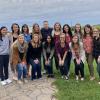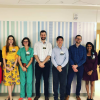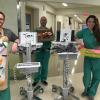About the Program
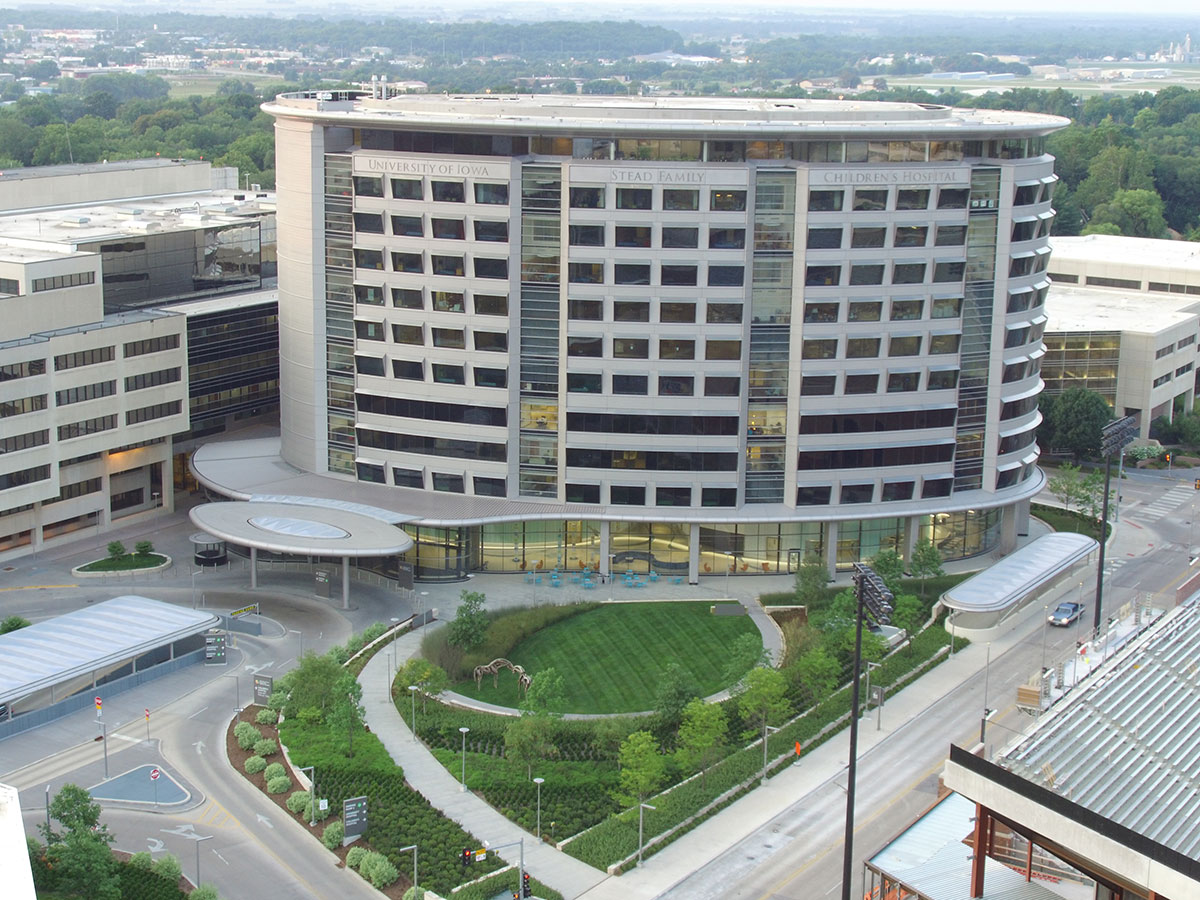 Our Training Program
Our Training Program
- A five-year fully integrated program (two years of pediatrics, three years of neurology) housed within the same institution, allowing the formation of strong peer relationships and long-term faculty mentorships
- Excellent sister programs in General Pediatrics and Adult Neurology
- Exposure to a wide variety of clinical problems with in-depth experience in our strong resident Continuity of Care Clinics–residents keep even the most challenging patients with the flexibility to have different faculty staffing individual patients.
- A strong commitment to creating well-rounded physicians by fostering a growth-mindset attitude, ensuring adequate wellness programming in a family-friendly environment, and of course a rigorous academic curriculum
Our Faculty
We have the privilege of hosting numerous distinguished faculty with expertise in child neurology, epilepsy, neuromuscular disorders, neonatal neurology, neuro-oncology, headache, neuro-connectivity, and molecular neurology, who, despite their achievements, still retain their “Iowa Nice” attitudes.
Our Research
- Sponsored by NIH, CDC, March of Dimes, Children’s Miracle Network, and other agencies with faculty research labs housed in the Iowa Neuroscience Institute
- Diverse research topics including epilepsy pharmacology, the molecular biology and genetics of epilepsy and neuromuscular disorders, numerous clinical trials, and non-invasive brain stimulation.
- To discover more visit our Child Neurology Division Google Schoolar Page.
Our Facilities and Community
- We practice in the new state-of-the-art University of Iowa Stead Family Children’s Hospital.
- Iowa City offers the ideal mix of a small college-town experience with big-city cultural events that make it one of the most livable cities in America.
- Our division has a strong commitment to community engagement through activities such as the epilepsy walk, muscular dystrophy camps and conferences, community outreach clinics, and annual fundraisers.
Quick Facts
Number of categorical residents accepted each year: 2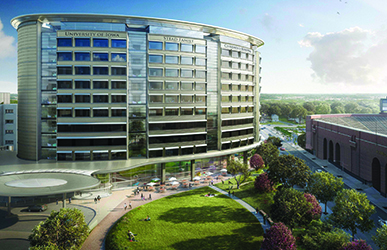
Preliminary Years: The general pediatrics preliminary years requirement is fulfilled with the Pediatric Residency at the University of Iowa Stead Family Children’s Hospital.
Benefits include:
- Competitive stipends
- Comprehensive medical, dental, hospitalization and pharmacy benefits for residents/fellows and their dependents
- 21 days of annual paid time off.
Location: Most rotations are done at University of Iowa Stead Family Children’s Hospital, in Iowa City. The resident will also rotate in adult neurology at the University of Iowa Hospitals and Clinics, which is on the same campus as the children’s hospital.
Research: Residents are required to complete scholarly activity, quality improvement project, and morbidity/mortality conference during residency. Further research and scholarly activities are encouraged and supported.
Clinical Curriculum
Pediatric Years
Dual Board Eligible Track (Pediatrics & Child Neurology Boards)
Preliminary training in Pediatrics at the University of Iowa will encompass the requirements set forth by the American Board of Pediatrics. The two-year preliminary pediatric training will include both inpatient and outpatient rotations, exposing the resident to a wide range of clinical problems of varied complexity as well as in-depth experience in primary care. You will receive broad experience in all aspects of human growth and development. For more specific information on pediatric residency rotations, please refer to our pediatric residency page.
Single Board Eligible Track (Child Neurology Board)
This is a new program option given that most Child Neurologists do not practice General Pediatrics or become Peds Board certified. The preliminary training in Pediatrics will be closely aligned with the above tradional pathway with added flexibility of starting Child Neurology continuity clinic one year earlier and more ability to personalize rotations within the first two years.
Neurology Immersion Block
During the last rotation of the year, all PGY2 residents participate in the Neurology Immersion Block with the adult neurology PGY1 classmates. This rotation is an introduction to neurology residency, which includes:
- Neurological emergency lectures
- Quizzes
- Workshops (neuroanatomy, adult and child neuro exam, EMG, EEG, lumbar puncture)
- Mock code stroke and status epilepticus
- Shadow calls
- Team building and wellness/relaxation exercises
Child Neurology Years
PGY3
- Adult General Neurology Inpatient
- Adult Neurology Clinic
- Adult Stroke (x2)
- Neurosurgery and Neuro-Interventional Neurology
- Child Neurology (x5)
- EEG/EMG
- Peds EEG
- Elective
PGY4
- Adult General Neuro Inpatient Senior
- Adult Neurology Clinic
- Adult Neurology Consults
- Child Neurology (x5)
- Child Psychiatry
- Neurorehabilitation
- Elective (x3)
PGY5
- Adult Neurology Clinic
- Adult Neurology Consults
- Child Neurology (x3)
- Neuropathology
- Neuroradiology
- Neuro-Ophthalmology
- Elective (x5)
Paid Time Off
- 21 days per year (15 workdays and 6 weekend days)–this does not roll over
- 5 Personal days per year
COC Clinic
Throughout the three years, the resident will have a child neurology continuity clinic that meets one afternoon per week. You will work one on one with a dedicated faculty member that changes every 6 months. Together you will work through tailored professional development goals and practical skill building to hone your skills as a child neurologist.
Didactic Curriculum
Below is a sample of the core didactic program. Lectures for the residents take place Monday – Friday at noon. The Department of Neurology Grand Rounds features the department’s faculty members, guest lecturers, visiting scholars, and live patient case presentations.
Sample Didactic Schedule
Monday
- Cerebrovascular Neurology Conference
- Epilepsy Surgery Conference (every other week)
- Child Neurology Clinical Conference [4 to 5 p.m.]
- Journal Club [4 to 5 p.m.] (1st week)
Tuesday
- Grand Rounds
Wednesday
- Neuroimmunology Conference
Thursday
-
Child Neurology Core Lecture
- Child Neurology Grand Rounds (3rd Thursday of the month)
Friday
- Neuromuscular Medicine alternating with Epilepsy (1st, 2nd and 3rd weeks)
- Research Seminar (4th week)
Lectures are from 12 to 1 p.m., unless noted otherwise.
Optional Conferences
Residents have the opportunity to attend various multi-disciplinary lectures such as:
- Neuropathology/Oncology Conference – Tuesday, 7 to 8 a.m.
- Neuro-Ophthalmology Conference – Wednesday through Friday, 7:30 to 8 a.m.
- Neuromuscular (biopsy) – Friday, 7:30 to 8:30 a.m.
- Pediatric Grand Rounds – Friday, noon to 1 p.m.
Research Opportunities for Residents
Providing outstanding research training and opportunities is a major objective of our program. Our department is among the top departments of pediatrics in the U.S. in terms of NIH research funding, and the Carver College of Medicine has strong basic science departments.
We have excellent opportunities for research training and experience within the Division of Pediatric Neurology, but we also encourage our residents to explore training opportunities in research laboratories elsewhere in the Department of Pediatrics or within the Colleges of Medicine and Public Health.
Current resident scholarly activities:
- Cole (PGY5) and Czech (peds epilepsy): Primary diffuse leptomeningeal melanomatosis (PLM): Case report of rare pediatric malignancy presenting with transient hemisensory changes.
- Cole (PGY5) and Mathews (peds neuromuscular): Esophageal, Bowel, and Bladder Symptoms in FSHD. A Questionnaire-based study investigating prevalence of GI and GU symptoms in patients with facioscapulohumeral muscular dystrophy.
- Jeno (PGY4) and Ciliberto (peds epilepsy): Comparing characteristics and outcome of palliative and definitive pediatric epilepsy surgery patients using the Pediatric Epilepsy Research Consortium (PERC) Surgery Database. Submitted to the Annual Epilepsy Society Meeting.
- Jeno (PGY4) and Newell (Critical Care): IRB-approved research project on Pediatric Abusive Head Trauma comparing cytotoxic edema and abusive head trauma patients to other children with accidental hypoxic injury.
- Jagadish (PGY3) and Thati Ganganna (peds epilepsy): IRB-approved chart review retrospective study on Efficacy of anti-epileptic drugs in Childhood epilepsy with centrotemporal spikes (CECTS).
- Jagadish (PGY3) and Glykys (peds neuro): IRB Approved retrospective analysis on the Duration of acute phenobarbital treatment in HIE patients with neonatal seizures and the risk of future seizures at 6 months and 1 year of age.
Recent Peer Reviewed Publications:
Cole M, Zhorne L, Glykys J. Atypical Presentation of Primary Stabbing Headache in a Patient With Type 3 Gaucher Disease. Pediatr Neurol. 2021 Mar;116:57-58. doi: 10.1016/j.pediatrneurol.2020.12.002. Epub 2020 Dec 13. PMID: 33486419.
Jagadish S, Singer W, Kotagal S. Autonomic dysfunction in childhood hypersomnia disorders. Sleep Med. 2021 Feb;78:43-48. doi: 10.1016/j.sleep.2020.11.040. Epub 2020 Dec 8. PMID: 33385777.
Ng BG, Eklund EA, Shiryaev SA, Dong YY, Abbott MA, Asteggiano C, Bamshad MJ, Barr E, Bernstein JA, Chelakkadan S, Christodoulou J, Chung WK, Ciliberto MA, Cousin J, Gardiner F, Ghosh S, Graf WD, Grunewald S, Hammond K, Hauser NS, Hoganson GE, Houck KM, Kohler JN, Morava E, Larson AA, Liu P, Madathil S, McCormack C, Meeks NJL, Miller R, Monaghan KG, Nickerson DA, Palculict TB, Papazoglu GM, Pletcher BA, Scheffer IE, Schenone AB, Schnur RE, Si Y, Rowe LJ, Serrano Russi AH, Russo RS, Thabet F, Tuite A, Villanueva MM, Wang RY, Webster RI, Wilson D, Zalan A, Network UD; University of Washington Center for Mendelian Genomics (UW-CMG), Wolfe LA, Rosenfeld JA, Rhodes L, Freeze HH. Predominant and novel de novo variants in 29 individuals with ALG13 deficiency: Clinical description, biomarker status, biochemical analysis and treatment suggestions. J Inherit Metab Dis. 2020 Jul 18. doi: 10.1002/jimd.12290. Epub ahead of print. (PMID: 32681751)
Kouri I, Mathews K, Joshi C. “Facial Weakness and Ophthalmoplegia in a 4-Day-Old Infant”. Semin Pediatr Neurol. 2018 Jul; 26:63-66. doi: 10.1016/j.spen.2017.03.008. Epub 2017 Apr 2.
Holec M, Nagahama Y, Kovach C, Joshi C. Rethinking the Magnetic Resonance Imaging Findings in Early Rasmussen Encephalitis: A Case Report and Review of the Literature. Pediatr Neurol. 2016 Jun;59:85-9. doi: 10.1016/j.pediatrneurol.2015.12.004. Epub 2015 Dec 19. PMID: 27004940
